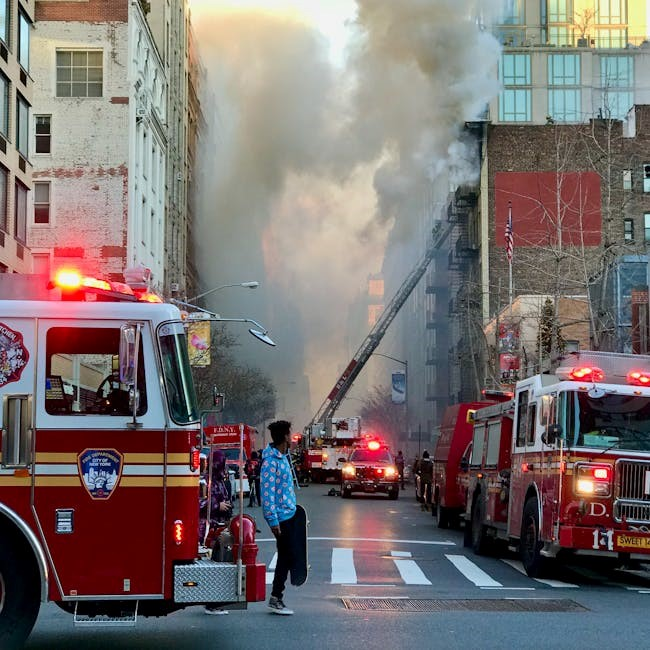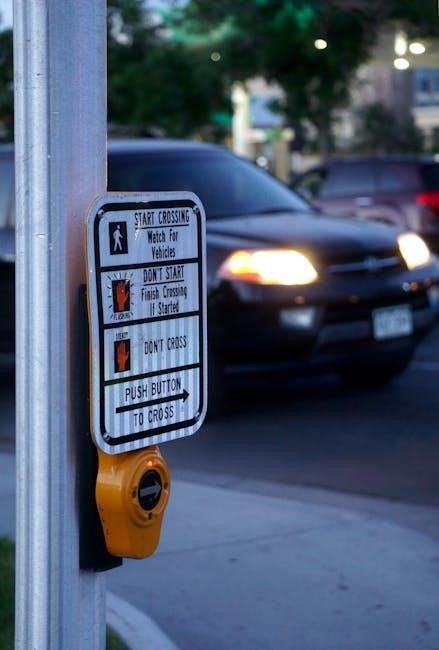First Alert smoke detectors are leading home safety devices, providing reliable early fire detection. Their recent collaboration with Google enhances smart home integration, advancing fire safety technology.

1.1 Overview of First Alert Smoke Detectors

First Alert smoke detectors are trusted devices designed to enhance home safety by providing early detection of fires. Known for their reliability and ease of use, these detectors offer a range of models, from basic battery-powered units to advanced hardwired and smart-enabled options. Recently, First Alert collaborated with Google to develop a new smart smoke detector compatible with existing Nest Protect systems, further integrating fire safety into smart home ecosystems. Their products are widely recognized for their durability, user-friendly features, and compliance with safety standards. Whether for residential or commercial use, First Alert smoke detectors remain a popular choice for preventing fire-related disasters.
1.2 Importance of Smoke Detectors in Home Safety
Smoke detectors play a critical role in home safety by providing early warnings of potential fires, allowing residents to act quickly and prevent disasters. According to safety experts, working smoke detectors can reduce fire-related fatalities by up to 50%. They act as the first line of defense, alerting occupants to dangers even before visible signs of fire appear. This early detection is crucial for evacuating safely and minimizing property damage. Additionally, smoke detectors are often required by local building codes and insurance policies, ensuring compliance with safety regulations. Their presence not only saves lives but also offers peace of mind for homeowners and families.
1.3 Brief History of First Alert Smoke Detectors
First Alert, a trusted name in home safety, has a rich history dating back to its founding in 1958. The company pioneered affordable smoke detection technology, introducing the first battery-powered smoke detector in 1975. This innovation revolutionized home safety, making smoke detectors accessible to every household. Over the years, First Alert has continued to evolve, embracing advanced technologies like smart home integration. Recently, in 2025, they collaborated with Google to enhance their smart smoke alarm capabilities, ensuring compatibility with modern smart home systems. This partnership underscores their commitment to staying at the forefront of fire safety innovation, protecting lives for decades.
Features and Benefits of First Alert Smoke Detectors

First Alert smoke detectors offer advanced sensors, smart home integration, and reliable alerts, ensuring comprehensive fire safety with minimal false alarms and easy maintenance, featuring sleek designs.
2.1 Types of Smoke Detectors Offered by First Alert
First Alert offers a variety of smoke detectors, including hardwired, battery-powered, and smart models. Their hardwired detectors provide reliable performance with battery backup, while battery-powered options offer ease of installation. Smart smoke detectors, like the SA511CN2-3ST, integrate with smart home systems, enabling remote alerts and voice notifications. Additionally, First Alert provides combination smoke and carbon monoxide detectors, such as the 9120BF, which offer dual protection. Their plug-in detectors with battery backup ensure continuous monitoring. With models featuring photoelectric sensors, ionization sensors, or dual sensors, First Alert caters to different safety needs, ensuring comprehensive protection for homes and families.
2.2 Key Features of First Alert Smoke Detectors
First Alert smoke detectors boast advanced features for enhanced safety. They include voice alerts, which verbally indicate the location of the threat, and smart integration with systems like Google Nest. Many models offer battery backup, ensuring operation during power outages, while others feature tamper-resistant designs to prevent removal. Some detectors include hush buttons to silence false alarms and test buttons for quick functionality checks. Select models also provide split-second detection, reducing response time in emergencies. With features like 10-year sealed batteries and dual-sensor technology, First Alert detectors deliver reliable performance and peace of mind. Their collaboration with Google further enhances smart home compatibility, offering real-time notifications and seamless control.

2.3 Benefits of Using First Alert Smoke Detectors
First Alert smoke detectors offer numerous benefits, enhancing home safety and convenience. Their advanced features, such as voice alerts and smart integration, provide early detection and clear communication. Battery backup ensures functionality during power outages, while tamper-resistant designs prevent unauthorized removal. The hush button allows users to silence false alarms quickly, and the test button ensures proper operation. With 10-year sealed batteries, maintenance is minimized, and reliability is maximized. Their collaboration with Google Nest enables smart home integration, offering remote notifications and enhanced control. These detectors provide peace of mind, ensuring rapid response to threats and protecting homes and families effectively.
Installation and Setup Guide
Installing First Alert smoke detectors involves selecting optimal locations, following step-by-step instructions, and ensuring proper mounting and wiring. Testing post-installation guarantees functionality and safety.
3.1 Choosing the Right Location for Installation
Proper placement of First Alert smoke detectors is crucial for effective fire detection. Install detectors on every level of your home, inside and outside sleeping areas. Position them high on walls or ceilings, at least 10 feet away from cooking appliances to minimize false alarms. Ensure coverage in living spaces, hallways, and near stairways. For larger homes, consider interconnected systems to enhance safety. Avoid areas with high humidity or extreme temperatures. Follow local fire safety codes and manufacturer guidelines for optimal placement. Strategic installation ensures comprehensive protection and early warning in case of emergencies.
3.2 Step-by-Step Installation Process
Begin by unpacking the First Alert smoke detector and ensuring all components are included. Choose a location based on the manufacturer’s guidelines, typically on ceilings or high walls. For battery-powered models, insert the batteries securely. For hardwired detectors, turn off the power at the circuit breaker and connect the wires carefully. Mount the base plate using screws or adhesive strips, ensuring it is level. Attach the detector to the base and tighten firmly. Restore power for hardwired models and test the alarm by pressing the test button. Ensure connectivity if integrating with smart home systems. Refer to the manual for specific wiring diagrams and troubleshooting tips. Proper installation ensures reliable performance and safety.
3.3 Mounting and Wiring the Smoke Detector
Mounting and wiring your First Alert smoke detector requires careful attention to ensure proper function. Begin by attaching the base plate to the ceiling or wall using the provided screws or adhesive strips. For hardwired models, switch off the power at the circuit breaker before connecting the wires to avoid electrical shock. Match the black (hot) and white (neutral) wires to the corresponding terminals on the detector. Secure the detector to the base plate and tighten firmly. If using a battery-powered model, skip the wiring step and insert the batteries as instructed. Ensure the detector is level and plumb for accurate operation. After installation, test the alarm to confirm it is functioning correctly. Refer to the manual for specific wiring diagrams and safety precautions.
3.4 Testing the Smoke Detector After Installation
Testing your First Alert smoke detector after installation is crucial to ensure it functions correctly. Press and hold the test button until the alarm sounds, confirming the detector is operational. For hardwired models, test the interconnectivity by triggering one detector and ensuring all connected units alarm. Use a smoke test spray or canned smoke to simulate real conditions and verify the sensor’s sensitivity. Check for any error codes or LED indicators, which may signal issues. Refer to the manual for specific testing instructions tailored to your model. Regular testing ensures your smoke detector provides reliable protection, giving you peace of mind and compliance with safety standards.
How to Use and Maintain Your Smoke Detector
Regularly test your First Alert smoke detector and clean dust from sensors to ensure optimal performance. Replace batteries annually and check for expiration dates to maintain reliability.
4.1 Understanding the Basic Functions of the Smoke Detector
First Alert smoke detectors are designed to detect smoke and alert occupants of potential fires. They feature sensors that trigger alarms when smoke is present, ensuring early warning. Most models include a test/silence button to check functionality or mute false alarms. Some detectors also have low-battery indicators, emitting chirps when replacement is needed. Advanced models may include features like voice alerts or smart notifications. Understanding these functions helps users respond promptly to emergencies. Regular testing ensures reliability, while silence buttons prevent unnecessary disruptions. Familiarizing yourself with these features enhances home safety and ensures your detector operates effectively in critical situations.
4.2 Testing and Silencing the Smoke Detector
Testing your First Alert smoke detector ensures it functions correctly. Press the test button to activate the alarm, verifying it emits a loud, clear sound. If the alarm is too sensitive, silencing it during false alarms is essential. Use the silence button to temporarily mute the detector, preventing unnecessary disruptions. Regular testing helps confirm the device is operational, while silencing avoids false alarm stress. Always ensure the detector is reactivated after silencing to maintain home safety. Proper testing and silencing practices ensure your smoke detector remains reliable and effective in emergency situations, providing peace of mind for you and your family.
4.3 Cleaning and Maintaining the Smoke Detector
Regular cleaning and maintenance are crucial for ensuring your First Alert smoke detector functions optimally. Dust and debris can accumulate inside the device, reducing its sensitivity. Use a soft brush or vacuum cleaner to gently remove dust from the exterior and interior vents. Avoid using harsh chemicals or water, as they may damage the sensor. For models with removable covers, take them off and clean the inside with a soft cloth. Perform this maintenance every 30 days to prevent false alarms and ensure accurate detection. Additionally, check for any corrosion or wear on the battery terminals and replace them if necessary. Proper upkeep extends the lifespan of your smoke detector and ensures reliable performance in emergencies.
4.4 Replacing Batteries and Parts
Replacing batteries and parts in your First Alert smoke detector is essential for maintaining its functionality. Most models use 9-volt alkaline batteries, which should be replaced every 6 to 12 months or when the low-battery chirp sounds. To replace the battery, open the detector’s compartment, remove the old battery, and insert the new one, ensuring proper alignment. For hardwired models, turn off the power at the circuit breaker before replacing batteries or parts. If the smoke detector has a removable sensor or cover, clean or replace it as needed. Always use genuine First Alert replacement parts to ensure compatibility and reliability. Refer to your manual for specific instructions, as procedures may vary by model.

Troubleshooting Common Issues
Identify and resolve common problems like false alarms, chirping, or sensor malfunctions. Clean detectors, check for obstructions, and ensure proper installation to maintain functionality and reliability.
5.1 Common Problems with Smoke Detectors
Smoke detectors often face issues like false alarms, which can be triggered by dust, steam, or cooking fumes. Another common problem is the low-battery chirp, indicating the need for replacement.
Connectivity issues may arise in smart models, such as lost Wi-Fi connections or failed integration with other smart devices. Additionally, sensor malfunctions can cause erratic behavior or complete failure to detect smoke.
Physical damage or improper installation can also lead to inconsistent performance. Regular maintenance, such as cleaning the sensor and ensuring proper wiring, is essential to prevent these common problems and ensure reliable operation.
5.2 Why Your Smoke Detector Might Be Beeping
Your smoke detector may beep due to a low battery, signaling the need for replacement. This is a common issue, especially in battery-powered models.
False alarms triggered by smoke, steam, or cooking fumes can also cause beeping. Cleaning the detector regularly helps reduce such false triggers.
In some cases, the sensor may be overly sensitive, reacting to dust or insects. Ensure the detector is free from debris to maintain proper function.
For hardwired models, wiring issues or power outages can cause intermittent beeping. Always check connections and consult a professional if problems persist.
5.3 How to Fix a False Alarm
To fix a false alarm, press and hold the test/silence button until the beeping stops. This temporarily mutes the detector, allowing you to investigate the cause.
Next, clean the smoke detector by gently vacuuming or using a soft brush to remove dust, dirt, or insects that may have triggered the alarm.
Check for environmental factors like steam, cooking fumes, or strong odors near the detector. Relocate it if necessary to minimize false triggers.
Ensure the detector is installed at least 10 feet away from cooking appliances and bathrooms to reduce interference from everyday activities.
If the issue persists, consider replacing the battery or consulting the user manual for specific troubleshooting steps tailored to your model.
5.4 Resetting the Smoke Detector
To reset your First Alert smoke detector, start by removing it from the mounting bracket. Take out the battery and press and hold the test button for 15-20 seconds to discharge any stored power.
Reinstall the battery and mount the detector back on the bracket. This process resets the device, clearing any error states or false alarms.
For hardwired models, turn off the power at the circuit breaker, wait 30 seconds, and then restore power. This ensures a full system reset.
Resetting helps resolve issues like false alarms or sensor malfunctions. If problems persist, refer to the manual or contact customer support for further assistance.

Compliance and Regulations
First Alert smoke detectors meet local and national fire safety regulations, ensuring compliance with building codes and certification standards for reliable protection and legal requirements.
6.1 Local and National Fire Safety Regulations
First Alert smoke detectors are designed to meet both local and national fire safety regulations, ensuring compliance with standards set by authorities. These regulations often require smoke detectors to be installed in specific locations, such as bedrooms and hallways, and to meet certain sensitivity and response standards. In the U.S., for example, smoke detectors must comply with UL 217 and NFPA 72 standards, which outline requirements for smoke alarm performance and installation. Adherence to these regulations ensures that First Alert smoke detectors provide reliable protection and meet legal requirements for home and building safety. Proper installation and maintenance are also critical to compliance.
6.2 Certifications and Standards for Smoke Detectors
First Alert smoke detectors are certified to meet rigorous safety standards, ensuring reliability and effectiveness in fire detection. They comply with UL 217, which outlines requirements for smoke alarm performance, including sensitivity and response time. Additionally, they meet NFPA 72 standards, which cover installation and maintenance guidelines. These certifications ensure that First Alert smoke detectors provide consistent and dependable protection. Many models also carry ETL and CSA certifications, further verifying their adherence to safety protocols. By meeting these standards, First Alert smoke detectors are trusted for their ability to protect lives and property effectively. These certifications are essential for ensuring compliance with fire safety regulations.
6.3 Ensuring Compliance with Building Codes
First Alert smoke detectors are designed to meet local and national building codes, ensuring compliance with fire safety regulations. They adhere to standards set by authorities like the International Residential Code (IRC) and the International Fire Code (IFC). Proper installation, as outlined in the manual, ensures detectors are placed in required areas, such as sleeping rooms and hallways. This compliance helps homeowners avoid fines and ensures safety. By following the manual’s guidelines, users can guarantee their smoke detectors meet all necessary building codes, providing both legal compliance and enhanced fire protection for their homes.
Integration with Smart Home Systems
First Alert smoke detectors integrate seamlessly with smart home systems, enhancing safety through voice alerts and remote monitoring via compatible platforms like Google Nest and Alexa.
7.1 Compatibility with Smart Home Devices
First Alert smoke detectors are designed to integrate with popular smart home systems, including Google Nest and Amazon Alexa. This compatibility allows users to receive voice alerts and remote monitoring through apps like Google Home or Alexa. The detectors can also connect with other smart devices, creating a unified safety network. Real-time notifications ensure users are alerted to potential dangers, even when away from home. This seamless integration enhances home safety while maintaining ease of use, making it a convenient addition to any smart home setup. Compatibility with these systems ensures that First Alert smoke detectors remain at the forefront of modern home safety technology.
7.2 Connecting Your Smoke Detector to Wi-Fi
To connect your First Alert smoke detector to Wi-Fi, start by downloading the compatible smart home app, such as Google Home or Nest. Open the app and select the option to add a new device. Choose your smoke detector from the list of available devices. Enter your Wi-Fi network password to complete the connection. Once connected, the detector will integrate with your smart home system, enabling features like remote notifications and voice alerts. Ensure your router is functioning properly and the detector is within range for a stable connection. If issues arise, restart the detector and router or check your network settings. This setup enhances safety and convenience in your home.
7.3 Using Smart Features for Enhanced Safety
First Alert smoke detectors offer advanced smart features that elevate home safety. Through integration with smart home systems, users receive real-time notifications on their smartphones or tablets in case of an alarm. Voice alerts via smart speakers provide clear instructions, ensuring quick action during emergencies. The detectors can also be monitored remotely, allowing users to check their status and receive updates. Customizable settings enable users to adjust sensitivity levels or silence alarms temporarily. Additionally, smart features like voice notifications in multiple rooms and integration with other smart devices enhance safety and convenience. These innovations ensure a proactive approach to fire safety, offering peace of mind for homeowners.

FAQs and Common Queries
Common questions include troubleshooting beeps, battery replacement, and false alarms. Users often ask about maintenance tips and compliance with safety standards. Additional support is available online.
8.1 Frequently Asked Questions About First Alert Smoke Detectors
Users often ask how First Alert smoke detectors work, with questions about sensor types and detection accuracy. Many inquire about installation requirements and optimal placement. Others seek advice on resolving issues like frequent beeping, which is usually due to low batteries or dust. There are also questions about compatibility with smart home systems, especially after Google’s partnership with First Alert. Maintenance queries, such as cleaning schedules and battery replacement, are common. Additionally, users want to know about compliance with local fire codes and how to ensure their detectors meet safety standards. These FAQs help users maximize their smoke detector’s efficiency and reliability.
8.2 Addressing Common Concerns and Misconceptions
Many users worry about false alarms, often caused by cooking or steam, not actual fires. Others believe hardwired detectors are overly complicated to install. Some think all smoke detectors are the same, but First Alert offers advanced features like smart integration. Concerns about battery life are common, but regular maintenance can prevent issues. Misconceptions about detector placement are addressed by guidelines in the manual. Users also question the necessity of multiple detectors, but safety standards recommend coverage throughout the home. Addressing these concerns ensures proper usage and maximizes safety. Regular testing and maintenance are key to avoiding false alarms and ensuring reliability.

8.3 Where to Find Additional Support and Resources
For further assistance, users can access the official First Alert website, which offers detailed manuals, troubleshooting guides, and FAQs. Customer support is available via phone or email for personalized help. Additionally, video tutorials on YouTube and installation guides on the First Alert app provide visual assistance. Community forums and social media groups also offer peer-to-peer advice. Retailers like Amazon and Home Depot often have Q&A sections with helpful insights. For advanced integration, resources on Google Nest and other smart home platforms are available. These resources ensure comprehensive support, helping users maximize their smoke detector’s performance and address any concerns effectively.

Conclusion and Final Thoughts
First Alert smoke detectors, with their innovative features and Google collaboration, ensure enhanced home safety. Proper installation and maintenance are crucial for optimal performance and peace of mind.
9.1 Summary of Key Points
First Alert smoke detectors are essential for home safety, offering reliable fire detection and innovative features. Their collaboration with Google enhances smart home integration, improving safety and convenience. Proper installation, regular testing, and maintenance are vital for optimal performance. Understanding basic functions, troubleshooting common issues, and adhering to safety regulations ensure maximum protection. Replacing batteries and parts on time prevents malfunctions, while cleaning ensures sensor accuracy. Compliance with local codes and standards guarantees reliability. By following the manual and maintaining the device, users can maximize efficiency and enjoy peace of mind. First Alert smoke detectors are a trusted choice for safeguarding homes and families.
9.2 Importance of Proper Usage and Maintenance
Proper usage and maintenance of First Alert smoke detectors are crucial for ensuring reliable performance and prolonging their lifespan. Regular testing, cleaning, and battery replacement prevent false alarms and maintain sensor accuracy. Adhering to the manual’s guidelines ensures compliance with safety standards, reducing fire risks. Neglecting maintenance can lead to malfunctioning detectors, compromising home and family safety. By following recommended practices, users can ensure their smoke detectors operate efficiently, providing early warnings in case of emergencies. Consistent upkeep also supports integration with smart home systems, enhancing overall safety and convenience. Proper care is essential for maximizing the effectiveness of these life-saving devices.
9.3 Final Tips for Maximizing Smoke Detector Efficiency
To maximize the efficiency of your First Alert smoke detector, ensure regular checks and battery replacements as outlined in the manual. Clean sensors and avoid placing detectors near cooking areas to reduce false alarms. Strategic placement in high-risk zones, like kitchens and bedrooms, enhances coverage. Utilize smart features for real-time alerts and remote monitoring. Always follow the manufacturer’s guidelines for installation and maintenance to ensure optimal performance. By combining proper usage with advanced features, you can create a safer living environment. Regular updates and adherence to safety standards further enhance reliability, ensuring your smoke detector operates at peak efficiency when it matters most.

